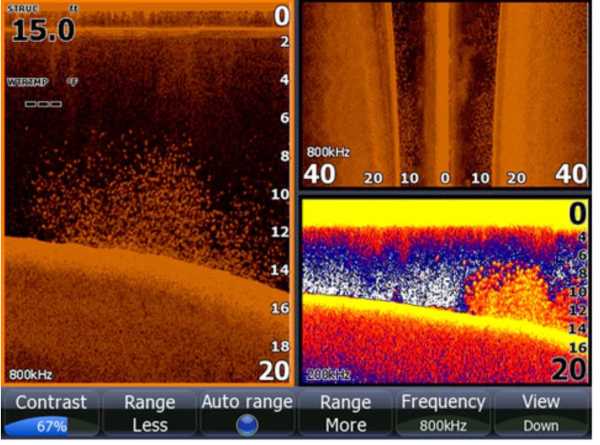Most of us don’t have forward scan sonar on our boats yet so we can go full video game mode when chasing bass—although that could change in a lot of households by December 26.
But we don’t necessarily need it at this time of year.
Plain old no-frills “fish finders” can be good enough for finding a lot of bass from now through early spring because we don’t have to see bass on the screen, all we have to do is see their chow.
And largemouths anywhere south of the line where the water gets hard at this time of year are totally into baitfish mode, primarily shad in giant lake chains like those on the Tennessee River but also blueback herring in some mid-South lakes like South Carolina’s Santee-Cooper lakes and Alabama’s Lewis Smith.
The great thing about winter fishing in these areas is that just about any serviceable sonar is capable of “seeing” a ball of several thousand shad huddled close to bottom. The schools can sometimes be massive, covering hundreds of yards and layered 20 feet deep. But even a small school of several hundred shows up as a big fat “snowball” on the screen.

And these winter snowballs are often surrounded by small individual dots. Some are crappies, some are white bass—and some are largemouth bass. The predatory fish don’t hang out far from the groceries in winter. When they get hungry, all they have to do is make a quick rush and they’ve got dinner.
While not all shad schools hold largemouths, many of them do. They typically show up as rice-sized dots close to bottom on down scanning sonar, or as small arches on conventional 2D sonar.
It’s possible to catch these fish by making vertical drops. Basically you need at least 15 feet—20 or more is better—between you and the fish. Otherwise, they usually sense the boat and either move out or huddle close to bottom and won’t bite. If you drift into range or ease along on the troller at lowest speeds, your odds of not spooking the fish are best.
Where to Find Baitfish in Winter
Shad often school next to steep vertical drops off rock ledges. Currently on my home lake, Guntersville, there are numerous pods on drops from around 20 down to 35 feet. They’re usually podded up right against the bottom.
Blueback herring, on the other hand, typically school in midwater. Again, they’re likely to be at 30 feet and deeper, schooling over channels that are 40 to 100 feet deep in some vertical lakes.
What to Fish
Baits that get deep quickly are essential to this tactic. Swim jigs can do the job, and because you can control the sink rate by altering the head weight as well as the soft plastic tail size and buoyancy, these lures can be made to fall slowly right in front of the fish, often successful for larger bass and for spotted bass schooled in mid-water next to herring schools.
Also effective are all-metal “blade baits” like the Heddon Sonar Blade, Bass Pro Shops XPS Lazer Blade and the Rapala Rap-Vee. Tail-spin baits like the classic Little George and Damiki Vault Tail also do the job.
These lures are typically fished with a pull-and-drop motion, causing them to vibrate as they’re pulled up two to four feet, then flutter back toward bottom like a dying shad. Strikes often come on the drop, so it takes a good touch to know when to set the hook. (Braided line helps, but you’ll need a rod’s length of 15-pound-test fluorocarbon to act as a “stiffener” and prevent the soft braid from looping over the treble hooks.)
It’s not nearly as interesting as working a spring shoreline with a buzzbait, frog or topwater, but for the next few months, chasing deep water baitballs may be the only game in town across much of bass country, and all you need to play is your old 2D sonar.
— Frank Sargeant
Frankmako1@gmail.com
